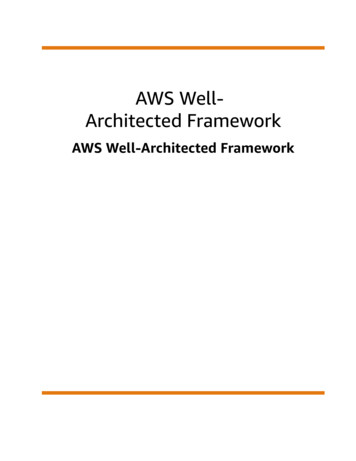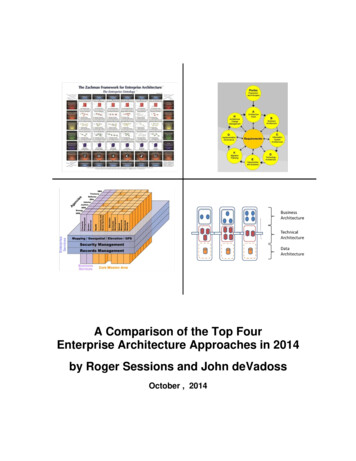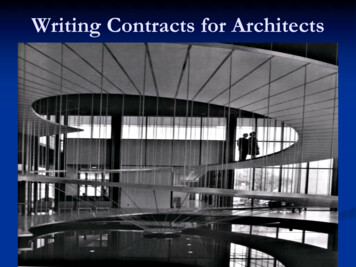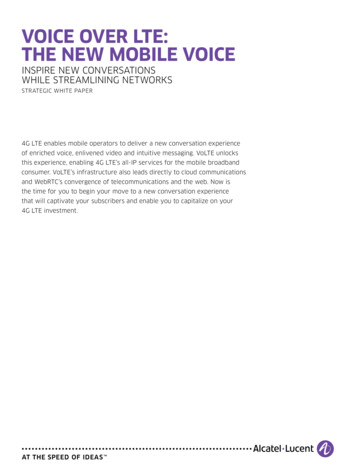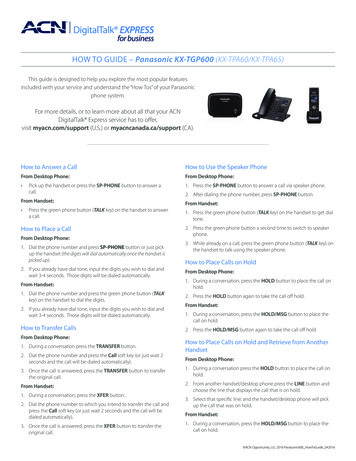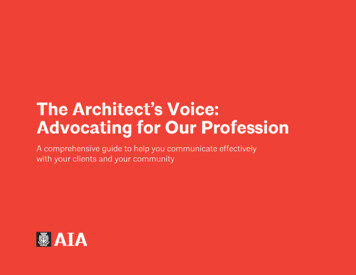
Transcription
The Architect’s Voice:Advocating for Our ProfessionA comprehensive guide to help you communicate effectivelywith your clients and your community
Table of contents06Introduction09Communication philosophy & message design process11Step 1: Key words14Step 2: Headlines15Step 3: Proof points16Step 4: Structuring your message19The architect’s contributions22Working with clients28Strengthening society34Designing solutions38Transforming communities45Opportunities to connect49Preparation
Dear AIA Member,While the public has great respect for architects,they have little understanding of what we do andwhy it matters.This guide helps bridge that gap. It uses messagepoints, statistics, and anecdotes that are supported bya tremendous amount of research to help you tell yourstory and advocate for the power of design.Whether you’re communicating that story in a formalclient meeting or a casual conversation, this guidehelps ensure your audience hears—and remembers—your message.The guide is organized into topic areas that aresummarized by these four bold statements:1. Architects work with clients: We are collaborative,approachable partners throughout every designprocess.2.Architects strengthen society: We demonstratethe critical role architecture and design have inour communities.3.Architects design solutions: We offer solutions thatshowcase our passion, creativity, experience, andprofessional education.4.Architects transform communities: We show howarchitecture improves the lives of individuals andthe vibrancy of communities.That’s a story we all need to tell. We emphasize these fourtopic areas here because they can easily be tailored to yourpersonal area of expertise, and they highlight the spirit ofour profession in an informative and memorable way.As an architect or design professional, you embody theseattributes and more—and we want to help you share thatimportant distinction with clients and the public.Sincerely,Robert Ivy, FAIA, Chief Executive OfficerThe American Institute of Architects
7/8IntroductionThis guide will prepare you forinteractions with clients, potential clientsand the public, whether in presentations,public speeches, or just conversationswith neighbors. It will help you expressand enhance your architectural story—the tale of what you do and how itbenefits all of us. And, that story willbe more memorable.This guide demonstrates a way of communicating thatallows your audience to remember positive messagesassociated with our profession.Architects work with a wide array of audiences andsettings, including:School boards/districtsLocal governmentsInstitutions (museums, libraries,higher education, religious institutions)Industrial organizationsHospitalsRetail/entertainment locationsSmall businessesContractors/home buildersBuilding owners (facilities)Residential design clientsArchitects need to seek out opportunities to engageand communicate with each of these audiences andteach them how we work with clients, design solutions,transform communities, and strengthen society.Inspiring leaders andcompanies.think, act andcommunicate exactly alike.And it’s the complete oppositeof everyone else.”–Simon Sinek, Author:“Start with Why”
Communicationphilosophy &message designprocess
11/12Communication philosophy & message design proccessThe messaging outlined in thisguide is built around the idea thatwe can influence what our listenershear, believe, and remember aboutarchitects and architecture.Whether you’re talking with colleagues, clients,or friends, following this guide will make yourcommunications more effective and memorable.After some research in preparing the guide and its topicsections, four bold declarations emerged. They notonly summarize our contributions but also describe ourvalues and commitment in a positive and pointed way.Architects work with clientsWe are collaborative, approachable partners throughoutevery design process.Architects strengthen societyWe demonstrate the critical role architecture and designhave in our communities.Architects design solutionsWe offer solutions that showcase our passion, creativity,experience, and professional education.Architects transform communitiesWe show how architecture improves the livesof individuals and the vibrancy of communities.Step 1: Key wordsBegin with a list of key words that conveyyour most important messages. Individualwords are the most powerful messagedriver. They are remembered, repeated,and related to by listeners. Here’s a listof key words that are associated witharchitects in a positive way.Use them, in their various tenses, when communicatingwith all audiences, large and small. The more you do,the more they will be remembered and repeated.Key wordsAccessibleActive listenerAdd valueAdvisersBeautifyBig pictureBuild communitiesRelationship eativeDynamicEconomicalEfficiency prove ionateProblem fulTransformativeTrustedUnderstandingValuedVision
Communication philosophy & message design proccess:13/14Step 1: Key wordsArchitect JargonArchitect Jargon is any word or phrase that yourlistener doesn’t use on a daily basis. It could be anacronym or a word that is specific to one particularindustry. Sometimes, jargon is a buzzword or a wordthat has a new meaning.How to handle negativestatements and questionsWhen responding to questions you perceive as negative,don’t repeat the negative word or concept. Instead,respond positively, and try to use some of the key wordslisted earlier.Using plain English can have the strongest impactwith any audience. Overly technical jargon and“archi-speak” is off-putting and can alienate clients,journalists, and the general public.For example, the negative word in the question belowis “expensive.” Rather than repeating “expensive,” youranswer might focus on an architect’s ability to “solveproblems” and “add value.”For example, your listener might not use words like“fenestration,” “chamber,” “parti,” or “planar”regularly, if ever.Question: How do I justify the cost of hiring anexpensive architect for a small renovation?Use “doors and windows” instead of fenestration,“room” versus chamber, or “design concept” as analternative to parti.Response: Architects add value to your project. Not onlyare they problem-solvers—they can also enable you toavoid costly problems. Chances are high that your smallrenovation will run into unexpected roadblocks thatrequire creative long-term solutions. Hiring an architectis a good investment—one that can pay for itself severaltimes over in the future.Statement: I don’t understand what the value is in hiringan architect to remodel my kitchen.TIP: Always ask yourself: “Does my audience understandthe technical or industry terms I’m using?” If the answeris no, you might be using JARGON.Response: A kitchen remodel is a significant factor inthe value of your home. Working with you, an architectcan maximize that value by revealing how to transformyour kitchen in the most creative and dynamic way, andyet still be economical and efficient.
Communication philosophy & message design proccess:15/16Step 2: Headlines & Step 3: Proof pointsStep 2: HeadlinesStep 3: Proof pointsUse headlines developed from the keyword list. Your headline is the briefmessage that you want your listener oraudience to remember and repeat—evenif they remember nothing else! Think ofthe headline as the one message youhope they later use to summarize andshare what you said.Back up your headline using proofpoints. This guide arms you with thetools you need to prove claims madein your headlines. They’re called proofpoints, and they include:HeadlineFor example, let’s say a residential client is meeting withyou about a new project, but his or her spouse or partnercan’t be present. Your headline is the succinct messageyou hope is relayed later to that spouse or partner.A good headline incorporates key words because they’reeasy to remember and repeat, and they reflect wellon architects and what we bring to the table. By ourdefinition, headlines are short, catchy, and make a claim.The term “headline” helps remind you to not include toomuch information.But your work isn’t done in just stating the headline—your listener will be waiting for you to prove it.1.Informational proofs: Facts and statistics2.Motivational proofs: Stories, anecdotes, and quotes.Stories are often the most memorable. A good storyincludes names, dialogue, action, challenges, and aresolution. And a great story includes emotionor humor.This guide contains several sample proof points you canuse to help prove your headline.
Communication philosophy & message design proccess:17/18Step 4: Structuring your messageStep 4: Structuringyour messageHeadline:Great design is necessary for a healthy community.Put it all together by designing yourmessage. You’ve gathered the basicbuilding materials: Key words headlines and proof points. Now putthem together and design your message.As an architect, you know design is crucial. Place thatsame value in how you communicate and structureyour message. Thoughtful design allows your listenerto remember what you say and addresses questionsand comments in a clear and concise way. Using welldesigned messages in your responses will help thelistener feel like he or she has been heard. Adding proofpoints in the form of stories or quotes help strengthenand support the message.HeadlineProofpoints(informational ormotivational)A completemessageProof point:(Informational) Design can have a substantial impacton public health. A Columbia University healthy-livingand walkability study found that participants living inneighborhoods designed to promote activity engaged in100 more minutes of moderate-intensity physical activityper week than the average American.OR(Motivational) “Our bodies, our health and buildings areforever connected. The links between architecture andwell-being are richer than merely affording safety frominjury; buildings can be, should be, agents of health –physical, mental and social health.”—Richard J. Jackson, MD MPH FAAP, AIA’s Local Leaders:Healthier Communities Through Design
The architect’scontributions
21/22The Architect’s contributionsOur goal is to help you tell your storywhen you’re responding to clients andothers who ask about what you do.The four topic areas outlined earlier can be easily tailoredto showcase your own area of expertise in a way that isboth informative and memorable.Notice how each declaration is supported by a headline,which is strengthened by a proof point. Those pointsshould be drawn from your own personal story.Architects work with clientsHeadline: I am my client’s partner. I feel an obligation—both personal and professional—to work with my clientin a true collaboration. What emerges is transformativedesign that satisfies and succeeds.Proof: Architects believe that what we do is not justwork, or a practical process, but it’s a passion. I get mygreatest creative enjoyment from a true team effort withmy client. It’s a kick to look back and say, “Together,we designed solutions. We created for the future. Andwe had fun.” For example (use a personal challenge/outcome story illustrating the power of collaboration).Architects strengthen societyHeadline: Architects help make our communities safer,healthier, and more livable. They guide collective visionsand help transform lives.Proof: We all want livable, sustainable, and inspiringcommunities, ones that respect the past, present, andfuture. Values, vision, and ethical responsibility can bedesigned into a community. For example (relate storyof a project whose design provided community benefits).Architects design solutionsHeadline: An architect’s education and experience allowhim or her to not only solve problems but also avoidthem. That resolve to provide solutions isn’t present inless structured design.Proof: Architects are problem-solvers and communitybuilders who bring passion and innovation in helpingclients achieve their goals. They take the client’s vision,find ways to enhance it, and lead it to reality. Forexample (use a story of how your work, or your firm’swork, added value to a vision or exceeded the client’sexpectations).Architects transform communitiesHeadline: An architect’s work turns a place into acommunity. We look beyond the blueprints and thebuildings. We want to improve the lives of the peoplearound us and the people who follow us.Proof: We see architectural solutions that can have alasting impact on the vibrancy of an entire community.We help buildings work better for society—and enablesociety to perform better. It’s what drives us in anyproject, large or small. For example (tell the storyof a project that was transformative for your clientor the community).
23/24The architect’s contributions: Working with clientsArchitects work with clientsVerbalize each headline, one at a time.Think of how to frame the narrativeintroduced by that headline. Thenchoose a proof point (story, quote, fact,statistic) to prove the headline. Yourgoal is to implant one takeaway onekey message you want your listenerto remember, such as: Architects takepride in not just working for clients,but working with them throughout thedesign process.HeadlinesThe following headlines were created using the keywords listed earlier in the guide.Our goal is to be transparent and approachablethrough all stages of a project.We are committed to being collaborative partners.Architects engage clients; they are committed towhat the clients want and need.As your architect, I see myself as your trusted advisorand partner throughout the design process. I willalways give you honest and straightforward counsel.I see the work that I do as my calling. Your designneeds become my priority.I like to think of the design process as a conversationbecause I’m dedicated to listening to your needs—and meeting them.HeadlineProofpointsA completemessageProof points and quotes from you, your firm, and yourclients make your headlines even more powerful to anyaudience.(informational ormotivational)TIP: Use these lists as an a la carte menu. Pick andchoose any headline that best relates to your audienceand then follow it with an appropriate proof point tovalidate your statement.
25/26The architect’s contributions: Working with clientsProof pointsAn architect’s insights(Motivational/informational) Patricia Shackelford readArchitectural Digest and loved architect Gil Schafer’sdesign for a Connecticut pool house. She sent him anote, asking him what he looks for in a client. She fearedthat an impressive budget would be number one on thelist. Instead Schafer said, “Budget is important but notthe most important.” He valued creativity, trust, and apositive attitude. Regarding budget, he said, “No matterhow big the budget, there is still a budget. Having thatboundary actually helps the creativity.”Ethical and trusted advisors(Informational) AIA members are bound by the AIACode of Ethics and Professional Conduct, assuringclients of their dedication to the highest standards ofprofessional practice. AIA architects must also fulfillannual continuing education requirements to maintaintheir certification and to stay current in the profession.Architects are trusted and respected(Informational) According to a 2014 Harris Poll,architecture is one of the highest-regarded professionsin the United States. AIA’s own research shows thesame findings.Remember, proof points prove the claims you make inyour headlines. They include informational proofs (factsand statistics) or motivational proofs (stories and quotes).Big picture for a fellowship hall(Motivational) A church wanted to create a fellowshiphall to accommodate its congregation for dinnersand receptions. What they did not envision—but theirarchitect did—was the array of other uses the spacecould provide, including yoga retreats, concerts, lectures,and more. Here’s what the chairman of the church’sFinance Committee wrote to their architect a yearafter the project was completed: “I thought of you thismorning when the Chapel of the Cross kicked off theSunday School year in the new facility. As you haveheard so many times by now, the new building has beenall that we had hoped—and much more. We are gratefulfor all the wonderful work that you and Lee and yourcolleagues at Hartman Cox contributed to make thisvision a reality.” Collaboration with the client enableda dream to become a space that is used multiple timesevery day.— Mary Kay Lanzillotta, FAIA, Hartman-Cox ArchitectsPartners in action(Informational) Architects depend on clients tocommunicate their design preferences, functionalrequirements, and budget. As the work progresses,a client’s timely response to questions and designsubmissions will help keep the project on track. It is alsoimportant for clients to not hesitate in raising concernsthey may have as the project proceeds, so they canbe addressed in the earliest stages. Working together,the architect and client can ensure the best possibleoutcome for the project.
27/28The architect’s contributions: Working with clientsSpace savers(Motivational) An architect was working with a clientwho had become frustrated trying to figure out how tomove her bakery into potential new space. The architectlistened carefully to how her operation functioned,including who made the batter, where the ingredientswere kept, and how the product was then moved tothe customer. In all, the architect spent three daysunderstanding how the bakery worked. As a result,the firm was able to design perfect solutions for thebakery’s move.QuotesUse good quotes, either in full or excerpted form, inbrochures or other communication pieces, and inpresentations.They were sincerely interested in making sure what wewanted to happen was happening When I wanted to beinterested or involved, there was no sense of ‘here comesthe homeowner again.’ They made it fun for me. I kind ofmiss our meetings.”—Homeowners Karen and John on collaborating with theirarchitects at Morgante WilsonRemember: Quotes are another way to help validateyour headline. Quotes are statements from reputablesources. They can be drawn from noted experts, othermembers, colleagues, the media, public figures in yourcommunity—and sometimes even you.I was hesitant to send [my changes] over to thearchitect but his response was extraordinary. Hethought the ideas were terrific and understood that’swhat we wanted in the house. He embraced that planimmediately and layered in detail after detail .He reallylistens to you. The starting point is understandingwhat the client wants. He’s very flexible and malleablethroughout the process without giving up on what hebelieves are strong architectural principles.—Homeowner Mark about an architect atMorgante WilsonArchitects are translators. They are able to workwith a client to understand their needs and translatethose needs into a specifically tailored environment.In a world where few things are truly customized,architects create something unique, reflecting theaspirations of their clients. The best design comesfrom true understanding—understanding that is theresult of close collaboration with a client.”—Paul Mankins, FAIA, substance architectureTruly successful projects are a result of collaborationbetween the client and the design team. Helpinga client create a project that fulfills and furtherstheir mission can only be accomplished with carefullistening and observation. The role of the architect isto help transform the client’s needs into the physicalreality of the vision.”—Mary Kay Lanzillotta, FAIA, Hartman-Cox Architects
29/30The architect’s contributions: Strengthening societiesArchitects strengthen societyVerbalize each headline. Frame thenarrative introduced by that headline.Choose a proof point (story, quote, fact,statistic) to prove the headline. Your“takeaway” goal on this topic: Architectsare proud of their role in strengtheningsociety through their profession.HeadlinesThe following headlines were created using the keywords listed earlier in the guide.Architects are a vital component of all design/buildand community projects.We add value and provide solutions in a varietyof ways.Architects build communities with a focus onsustainable outcomes.Design has always been crucial to peoples lives butnow it plays a greater role than ever before.HeadlineProofpointsA completemessage(informational ormotivational)Architects provide an essential connection betweenclients and the building team.Architects expand on your vision/concept/idea witha roadmap to guide building projects of every scaleand type.Architects are solution oriented.We are vital community partners who providevaluable skills and services.Great design is necessary for a healthy community.TIP: Remember, pick the headlines and accompanyingproof points that feel most appropriate for your audience.
31/32The architect’s contributions: Strengthening societiesProof pointsProof points validate the assertions made in yourheadlines. They include informational proofs (facts andstatistics) or motivational proofs (stories and quotes).Reinventing old spaces(Motivational/informational) Norwegian architectsturned an abandoned airport into Nansen Park, a spacewith housing, mixed development, and a public park.Better design, healthier communities(Informational) Design can have a substantial impacton public health. A Columbia University healthy-livingand walkability study found that participants living inneighborhoods designed to promote activity engaged in100 more minutes of moderate-intensity physical activityper week than the average American.Targeted problem solving(Motivational) Architects at the University ofKansas identify examples of what they call “urbanacupuncture”—projects that deliver the most helpfuladjustments to problems a community may not realizeit has. One of these was remapping the bus system inWyandotte County to provide more access to healthyfood options.Health and safety(Motivational) Architects’ professional responsibility isto protect the health, safety, and welfare of the public.Design—including active streets, thoughtful lightingstrategies, and open sightlines—can protect people frommore than physical harm. It can also remove real andperceived impediments that cause anxiety, stress, andpsychological harm.Better productivity, better business(Informational) Access to natural light through windowsmay raise productivity levels. In Orange County, Calif.,over a one-year period, students with the most daylightin their classrooms progressed 20 percent faster onmath tests and 26 percent faster on reading tests thanstudents with less daylight.As mentioned earlier, you can also use proof pointsfrom your own experiences to support the headlines.Personalizing the examples helps you remember thembetter and relate them in a more engaging way withyour audience.
33/34The architect’s contributions: Strengthening societiesQuotesAt their best, architects create direct, functional, andbeautiful buildings that engage their larger context tocreate something more than merely a structure, buta vitally important and contributing piece of a largerframework.”—Paul Mankins, FAIA, substance architectureArchitects help clients to imagine beyond the norm;helping them problem solve in creative ways that theclient may not have realized were possible.”—Rod Kruse, FAIA, BNIMArchitects are forging partnerships nationwide withschools of medicine and public health, taking a leadingrole in promoting walkable communities and visionaryurban planning as a way to combat the epidemic of noncommunicable diseases such as diabetes and obesity.”—Robert Ivy, FAIA, EVP/Chief Executive Officer, AIAArchitects design real homes for real people. I grewup in a home designed by an architect and it changedthe way I look at the world and helped me realize whatreally matters.”—Torrey Stanley Carleton, Hon. AIA, Executive Director,AIA San AntonioCommunity responses to CHS Field in Saint Paul,Minnesota, which transformed a great neighborhood intoa vital, energetic force in the city:I looked down all the way to Rice Park. Therewere 10,000 people in the ballpark and 4,000out on the street. You couldn’t tell where theballpark ended and the farmer’s market started.That created a sense of community.”—Mike Veeck, one of the team’s ownersWhen you build it in a way to flow into theneighborhood and, if you build it into acommunity that is already strong, it can reallyhave an accelerating impact. That’s what we’reseeing with CHS.”—Chris Coleman, St. Paul MayorCollect and craft quotes that relate to your experience orthat of your firm. Your clients can serve as great sourcesfor quotes, as well as those who have benefitted fromyour work.
35/36The architect’s contributions: Designing solutionsArchitects design solutionsAgain, these headlines include many ofyour key words. Your “takeaway” goal onthis topic: Architects pride themselveson being knowledgeable, well-roundedexperts who offer creative solutions.AIA architects have a rigorous continuingeducation process.My skills and expertise can help foster the bestsolutions to meet your needs.We learn from our experiences, and we bring thatinsight to our projects.Architects have specialized knowledge that helpthem as leaders in community design.I want to understand your ideas, and I want to usemy expertise to help you succeed.HeadlineProofpointsA completemessage(informational ormotivational)Skills and experience enable architects to not onlysolve construction problems but also prevent them.Architects and designers create value for your project.Proof pointsHeadlinesThe following headlines were created using the keywords listed earlier in the guide.We help bring the best solutions to your projectchallenges, and we help create new opportunities.We take pride in being well-rounded expertsin our field.Architects are highly educated and trained andgo through a rigorous testing process to earntheir licenses.Architects add value(Informational) Hiring an architect can save you moneyin many ways. Architects can monitor your budget andnegotiate to get the best materials and workmanship at agood price. An architect’s design can reduce energy andmaintenance costs. Architects can turn a difficult lot intoa successful building site. And they spend time planningand fully developing your ideas to avoid changes onceconstruction is under way.Collaborative partners(Motivational) Architects see the big picture foryour project. They help you explore what appeals to
37/38The architect’s contributions: Designing solutionsyou aesthetically and what you require functionally.They coordinate teams of design, engineering, andconstruction professionals; they sort through the mazeof building codes and zoning requirements; they ensureyour project is built the way it was intended.Designing for tomorrow’s needs: Reframingcourthouse design(Motivational) Architects and designers are deliberate infinding the right solutions for communities and society.For example, they are reinventing the design for publicbuildings, including judicial buildings and courthouses.The new designs better reflect our judicial needs in a 21stcentury society. (“Looking Sideways: Reframing CurrentCourthouse Design.” Research conducted by the ShapeComputation Lab (SCL) at the School of Architecture,Georgia Institute of Technology in partnership with theGSA and U.S. Courts.)Creative solutions for the greater good: Rural Studio(Motivational) Serving the community’s greater goodis ingrained in architects from the beginning. A greatexample of that is Auburn University’s Rural Studio.It was established to address the dire needs of one ofthe South’s poorest and most underserved regions.Students of this design/build program within Auburn’sarchitecture school build low-cost, affordable homesand community buildings for the residents of westernAlabama, where nearly 40 percent of residents live belowthe poverty line.QuotesArchitecture has changed in the past year by notfollowing any one particular trend, but by respondingto the local conditions and working within thatframework.”—Jon Dick, Archaeo ArchitectsEvery educational experience, every humaninteraction, and every project provides valuableexperience critical to the successful practice ofarchitecture. Our profession is a complex profession.Every day there is something new to learn—a newchallenge, a new opportunity, a new idea, a newway of thinking—every project benefits from theseexperiences.”—Rod Kruse, FAIA, BNIMWe know, looking forward, that architects will bein high demand to develop the kind of society andenvironment that will be conducive to living healthyand living well.”—Elizabeth Chu Richter, FAIA, Richter ArchitectsProof points and quotes from you, your firm, and yourclients make your headlines even more powerful toany audience.
39/40The architect’s contributions: Transforming communitiesArchitects transformcommunitiesArchitects act as stewards of the environment.My input will increase the economic value ofyour projects.Again, the following headlinesinclude many of your key words. Your“takeaway” goal on this topic: Architectscan help clients improve the lives ofindividuals and enhance the vibrancyof communities.HeadlineProofpointsA completemessage(informational ormotivational)HeadlinesMy job is to assess trends and look to the future.Design touches everyone.Architects enhance the spaces where we live,work and play.Architects can help to transform your communitiesfor the better.We are inspired, passionate agents of change.Our work can spark the vibrancy of a communityand improve the lives of its members.ProofsHospitals show good design improves lives(Motivational) Forward-thinking hospitals have realizedthat good design, which improves patients’ moods,can actually help people get well faster. “In the past,the design of hea
require creative long-term solutions. Hiring an architect is a good investment—one that can pay for itself several times over in the future. Statement: I don’t understand what the value is in hiring an architect to remodel my kitchen. Response: A kitchen remodel is a significant factor in the value of y


